Tim Reardon is one of our trustees and our treasurer. Tim lost his wife, Eileen, in a tragic car accident in Hamilton on Friday 7th December. The shock of this tragedy has been felt by all in our group.
Restoration by the community for the community. If you are interested in receiving an email notification every time the blog is updated then register your email on gullyrestoration@gmail.com. Co ordinators are Rex Bushell 854-0973 and Rod Lugton 855-9966 .
Friday, December 21, 2012
End of year round up in no particular order
Wetas
The eggs, laid in April, are hatching now in December. There is really no metamorphosis. The young Wetas resemble small adults and undergo several moults before they are fully grown at 45 to 50mm long. Their favoured food plants are Mahoe and Lace – bark species both of which we have planted in the gully.
Tui
We had regular visits of Tui throughout the latter part of the winter and spring. There was hope that they may stay round and nest but we don’t believe this happened. Once the willow flowers faded the Tui departed. When the flax that has been planted mature and start flowering the Tui should have a reason to stay around a bit longer and the longer they stay the more likely they are to nest.
We have hammered the pests this last year with 22 possums removed out of the gully and no more being caught. The volume of baits going through the 13 bait stations to control rats have dropped right off so we are reasonably confident that rats are also under control. Waikato Regional Council scientists are in the process of monitoring the rat population, or lack of it, at the moment so we are waiting to see what the results will be.
Unfortunately we have had an attack on our bait stations with three being removed and taken away along with at least three tracking stations. This is most disturbing. We have installed temporary signs at each of the three entrances to explain what we are doing in the hope that this will stop.
Track installed
This must be the years highlight. It makes moving around the gully so easy for us now on our working bees and there is evidence that there are a good number of people walking the track as well. This has a down side that it also lets people in that are hell bent of damaging things but it has an upside that the public can now see what restoration is being done. We thank the Hamilton City Council Envirofund for funding the materials for this project. Perry aggregate for donating pit sand and Acorn Building Supplies for a generous discount on the timber and other hardware.
 |
| The rubbish bin was made from one donated drum. |
We are pleasantly surprised how much rubbish is going into the rubbish bin. There was a worry that having a lid to lift may have deterred people from using it, but this does not seem to be the case.The amount thrown over the bridge has been reduced to almost nothing.
The shade house
This is full of plants which are all growing well. We have found that the distribution of water from the irrigation system is not that even. We are managing this now we know the areas that do not get as much water. Over all we are very pleased with it. We are in the process of building a potting table next to it.
A GREAT BIG END OF YEAR THANK YOU
To all those that have supported what we are doing and encouraged us with moral and material support a big thumbs up. While we should not single out any particular person we would like to thanks Gerard Kelly from Hamilton City Council for his ongoing support and advice. This all makes our job that much easier.
Tuesday, November 6, 2012
Is there Tui nesting in our gully?
There are two resident Tui in our gully.
What would be good would be to know whether they are nesting. If they do nest,
with the pest control we have done, there is a really good chance of the chicks
being reared to maturity. The thing to look out for is to see Tui carrying twigs
in their beaks and where they are building. The tree will not necessarily be a
native as Tui do not know the difference. A good nesting spot is a good nesting
spot to them. They are also likely to be very aggressive towards other birds,
particularly Mynas. If anyone sees this behaviour please let one of our group
know.
Rubbish bin installation
Any other long running project has been
completed along with its retro sign writing. We hope that it is robust enough
not to be damaged by hoons!
Shining Cuckoo heard but hard to see
The Shining Cuckoo over winters in the
pacific. It flies south for our summer and to nest - or lay its egg in a Grey Warbler’s
nest for the Warbler to incubate and rear. They have been heard in the gully
over the last couple of weeks. http://www.nzbirds.com/birds/pipiwharauroa.html
Click on this link to hear is song.
Chaffinch
The Chaffinch have been regularly seen
and heard in our gully. It is an interesting introduced bird in that it has adapted
to our bush areas. To quote A Field Guide to the Birds of NZ:” they are evenly distributed wherever there are
trees or shrubs from sea-level to 4500 feet and penetrate the bush as no other
finch has done.” One of our group heard a number of them at the top of Maungatautari
Mountain this week. That is a considerable distance from any farm land.
Thursday, September 27, 2012
All weather track completed 26th Sept 2012
 |
| North meets south |
It is with great pride that the team can
announce the joining of the tracks from each end to have an all weather foot
track running the full length of our gully. You can now go for a walk in your
ordinary walking shoes and not get any mud on them (well almost).
There is still a bit of finishing to do.
We are waiting for a delivery of millings (shingle) to put on top of the pit
sand and we would like to wire some of the board walk, that we feel could be
under pressure from flooding, to waratahs or trees. This is a great public
asset. Go for a walk and enjoy it.
NZ Pigeon (Kereru) in Hamilton
 |
| This photo was taken by a local at Lowry Bay, Wellington |
Wouldn't it be great to have Kereru back
in our city? Many cities in New Zealand have healthy populations so let’s try
and get them to sit on OUR power lines. If you have an open space like a gully
at the back of your place why not plant a Tawa and a Miro. If space is a bit
more limited perhaps a Nikau, Cabbage Tree or Pigeonwood may be more suitable.
We are planting for Kereru in Mangaiti
Gully. We have successfully encouraged the Tui to reside once more in Hamilton. Now it is time to target the Kereru.
Astelia in flower
We had to add this photo of an Astelia grandis in full flower. It can
be viewed just off the foot track that drops down the steps beside the St James
side of the foot bridge and winds its way through the tree ferns. It is on the right
just before the track turns left and heads to the little bridge over the
creek. Check it out.
Pests under control
We feel the rats and possums are well
under control and we are expecting a good breeding season for the birds. The
birds of particular interest are Fantail, Warbler and Morepork. If those of you that back onto the gully see or hear either a rat or possum please drop us an
email on gullyrestoration@gmail.com
. Thanks.
Perry Aggregate donated pit sand
We ran a bit short of pit sand while
completing the tracks that are within the boardwalk system. We approached Perry Aggregate
and they kindly donated three large trailer loads which we picked up from their
deposit in Te Rapa.
AGM minutes, financials and chairman report 2012
These have been posted onto “Trust AGM
Minutes” page listed on the left hand side of this home page. Trying to get the formatting
right drove me crazy so what you see is what you get. The blog does not like it
when I try and cut and paste anything that has formatting in it.
Thursday, September 6, 2012
Infrastructure Projects
By the time we publish our next news
letter we will have completed a number of projects that have been on the go for
some time. The biggest, without doubt, is the board walk / track. This
is very close to completion. Another two or three working bees and you will be
able to walk from the foot bridge in the south to Sexton Road in the north
without getting your shoes muddy! It has been a very satisfying project and all
the team are very proud of our achievement.
Banksia for Tui project
 This was very well supported with 56
orders coming in. However when I placed the order with HCC Nursery and they
passed the order on to the commercial nursery that was supplying them, HCC was
advised that they had all sold out.
This was very well supported with 56
orders coming in. However when I placed the order with HCC Nursery and they
passed the order on to the commercial nursery that was supplying them, HCC was
advised that they had all sold out.
As some of you might have noticed there
was a very good article in the Hamilton Press about Mangaiti Restoration Group
and about the Banksia Project. This appeared five weeks after the interview so
we were fielding calls from other people wanting the order Banksia. Although we
could not supply we made a lot more contacts and a number of them would be
interested if we did it again next season.
For those in Auckland, Banksia are not
invasive in the Waikato and for the native purist, we are not planting Banksia
in our gully, as it is a native flora reserve and yes there are natives that
feed Tui but this is about attracting Tui into the city not just feeding them
and Tui find Banksia very attractive during the winter period.
Invercargill, Kahikatea and Pigeons
 On a recent trip to Invercargill to
attend the Wetland Symposium this photo of Kahikatea was taken in an area just
south of the city, about Hamilton to Gordonton in distance. A close inspection
had to be made to be satisfied that they were actually Kahikatea. The area is interesting in that it has a high population of Kereru,
Native Pigeon. There are so many that there are road signs warning traffic of “Low
Flying Kereru” and there is a person in
the area that specializes in nursing
them back to health if they survive a hit. There was no information as to
whether the Kereru population is level, declining or increasing but it was
obvious that there was a health population.
On a recent trip to Invercargill to
attend the Wetland Symposium this photo of Kahikatea was taken in an area just
south of the city, about Hamilton to Gordonton in distance. A close inspection
had to be made to be satisfied that they were actually Kahikatea. The area is interesting in that it has a high population of Kereru,
Native Pigeon. There are so many that there are road signs warning traffic of “Low
Flying Kereru” and there is a person in
the area that specializes in nursing
them back to health if they survive a hit. There was no information as to
whether the Kereru population is level, declining or increasing but it was
obvious that there was a health population.
It has to be asked, if they are successfully
surviving in that ecosystem why not in Hamilton.
Wednesday, August 1, 2012
Board walk construction continues
 |
| Click on any photo to enlarge. |
With funding from HCC Envirofund for
materials we are powering ahead with the board walk and track construction. We
are all very excited about this project because it will link an all weather
track from the walk bridge at the south end of our restoration area right up to
the Sexton Road exit. After two working bees we have 30 metres completed and it
is looking really good.
Snails
These snails have been found in our
gully and have been identified by Kath Walker a conservation scientist for DOC
specialising in Powelliphanta. (A powelliphantaologist? Not sure if that is a
word). They are Oxychilus cellarius, or as commonly known. the cellar glass
snail. They are a pest species, introduced from Europe/UK and managing to
invade many disturbed lands in NZ; they are often found in gardens. They are
carnivorous, so likely to be destroying our very distinctive native (mostly vegetarian)
land snail fauna.
The latest update on the Weta homes
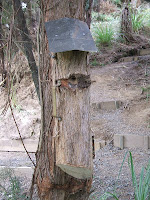 |
| 5 Star Weta Hotel! |
If you recall we started with a 30mm and
a 15mm bamboo stem and a month ago a 20mm stem was added. (20mm stems are
recommended by Forest & Bird).
Before the 20mm stems were added we had
4 of 5, 15mm stems occupied and none in the 30mm. On inspection last week we
had 3 of 5, 15mm stems in use, 2 of 5, 20mm stems in use, with 1 stem housing
2. 1 of 5, 30mm stems were in use. This looks like a juvenile, probably lost
and sure to move on. That is 7 Wetas in total.
In addition the 5 Star Hotel has been
occupied for some time. Today, it was noticed a second, not in the main
chamber, but just under the roof. Be careful if you go looking, it had legs
over hanging the gap between both halves of the wood.
Tree felling destroys canopy trees
 |
| Matai with it's head taken out |
The trees behind Oderings Nursery were
being felled and the tree fellers felled a tree right across the boundary into Mangaiti Reserve completely taking out a 10 year old
Rimu and taking the head out of a Matai. This was very disappointing. We grow
trees from seed and know how long it takes for a canopy tree like a Rimu and
Matai to grow. One quick act like this destroys 10 years of growth. That is
2022 to get a tree back to the same maturity.
Annual Tree Crop Ass. plant sale
Thursday, July 5, 2012
Great Winter Tucker for Tui

There are three houses around the foot
bridge that have Banksia growing in their
back yard. On a wet Wednesday when we were planting we could hear the Tui
singing in the Banksia trees. Banksia comes into flower in winter when there
are few nectar-bearing trees in flower, thus complementing the Kowhai which
starts flowering in spring.
On a request for the name of the species
observed at the University, the grounds manager said,” The tree you refer to is
the Banksia integrifolia, the tuis
love this tree and seem to get almost a year round food source. It’s a very
fast growing Banksia and one of the hardiest Banksia species”.
We are negotiating with a nursery to get
a price and quantity required for a bulk purchase of Banksia. When we get the
numbers we will let everyone know and see if we can get the numbers required.
We have access to other enviro networks so we will not be only reliant on our
group.
Getting Carex secta established in the pond
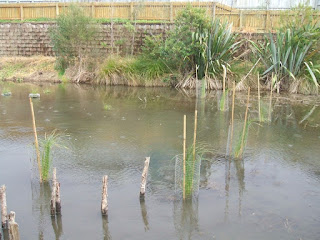
Carex
secta will happily grow in water but getting them
established is a bit of a challenge with ducks paddling them into the mud and
Pukeko pulling them out just for fun. We first tried covering them with 16
up-side-down hanging baskets. This stopped the ducks but not the Pukekos and
only three have survived. We acquired 6 wire mesh tree guards to use. These look
ideal. Once the 6 Carex are established we will plant another 6.
.
Winter Planting progress
 The winter is a busy time of the year
with planting in full swing. The area south of the foot bridge that has had
several sprays to get rid of the Glyceria has been planted in Manuka and Carex secta with a few kahikatea. All
these should tolerate wet ground.
The winter is a busy time of the year
with planting in full swing. The area south of the foot bridge that has had
several sprays to get rid of the Glyceria has been planted in Manuka and Carex secta with a few kahikatea. All
these should tolerate wet ground.
Eighty seven plants of mixed species
have been planted round the pond to fill in the gaps.
Sexton Road end of the gully has had over
500 plants go in at various locations.
That’s a total of 2,350 plants of which 1,450
have been HCC-supplied with the balance having been raised by our group and a
few purchased.
Epiphyte Collospermun hastatum
We
have introduced another epiphyte into the reserve. After installing it we read
that the epiphyte should be inserted directly into the sphagnum moss so it is
now a little different to the photo.
AGM 2012
on Tuesday 31 July
at 7pm
at 7 Carisbrook Place, Rototuna North,
Hamilton, 3210
The agenda will be notified later
Thursday, June 7, 2012
Weta Homes
 |
| double clip to enlarge |
On the
Coromandel, on two occasions a tap at a filleting bench has been home to a
weta. One had also taken up residence in the watering can hung up in a Ngaio
alongside the bench.
Last
year the Forest and Bird magazine had an article on wetas. It covered artificial
homes advising they be made from minimum 20mm diameter bamboo stem.
3 homes
were created using 15mm stem as this was the only bamboo available. One stem
was hung in the Ngaio while another in a Kanuka nearby, and a third in another
Kanuka at a different location within the section. Two weeks later upon
inspection one of the homes was occupied and after a further two weeks, all had
a resident weta.
Back in
Hamilton, the Mangaiti Gully group removed a fallen Kanuka and found two
naturally occurring weta homes in the trunk. The trunk that contained one of
these homes was secured on an existing Kanuka tree. The other trunk was split
length wise to expose the weta home, hinged for viewing then secured to another
Kanuka.
10
bamboo homes have now been installed amongst the Kanuka where the initial
discovery was made (alongside the walk bridge). A 15mm and a 30 mm stem have
been paired and attached to the Kanuka (see photo) in five locations that do
not appear to have naturally occurring homes. The length of the bamboo stem
varies up to 220mm. After two weeks 2 have been occupied. Both 15mm diam stems and the 2 longest ones, 220 and
180mm.
A Shade house
 This project has been on the boil for
some time. We have finally started the construction on council land down by the
foot bridge (see photo). With HCC under financial constraint no one knows what
the future plant supply is likely to be so it is important that we become more independent.
We have had excellent support with donations from a number of people. This
includes the supply of the base sleepers, the deer netting for security, wire, the
shade cloth, weed mat and an irrigation system.
This project has been on the boil for
some time. We have finally started the construction on council land down by the
foot bridge (see photo). With HCC under financial constraint no one knows what
the future plant supply is likely to be so it is important that we become more independent.
We have had excellent support with donations from a number of people. This
includes the supply of the base sleepers, the deer netting for security, wire, the
shade cloth, weed mat and an irrigation system.Summary to date of pest control
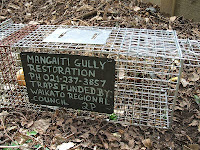 Possums
caught since December now totals 19. There has been
nothing in the traps for over two weeks now so it looks as though we may have
cleared out the resident possums.
Possums
caught since December now totals 19. There has been
nothing in the traps for over two weeks now so it looks as though we may have
cleared out the resident possums.
Rat
bait pellets eaten from our bait stations since we
started now totals 274. We were trialing one bait station which has been in
place since November last year and that had 48 eaten by March when we started
putting the other bait stations into the reserve. The last of the 13 were installed
by 20th April. The bait stations are serviced weekly. We are a bit
surprised that the uptake of baits has not had any noticeable reduction yet.
There must be a lot of rats out there or the bait pellets (Ditrac) is not
having any effect and we are just feeding them!! We are sure it is the former.
Funding success

This year we have been successful in obtaining funding from three sources.
1/ Trust Waikato supported us again with
$350 for potting mix. This enables us to grow native trees and shrub at
considerably less than if we had to purchase them. This is the second year we have
had this important funding.
2/ We applied for and were successful in
obtaining $2,000 from the HCC Envirofund to purchase materials to complete the
track and board walk from Sexton Road to the foot bridge. This is an important
infrastructure project and, when complete, will give us easy access to the length
of the restoration area.
3/ HCC made available to us about 100
old farm posts of miscellaneous types to sell on Trademe for funding. We were
successful in netting $452 in the sale. This has been set aside for plant
purchasing.
Friday, April 20, 2012
13 bait stations

We have finally got all 13 of our rat bait stations installed. The map shows the approximate location of each.
Some are really remote but numbers 8 and 5 are just off the track. Ditrac is the name of the pellets we are using. They do not pose a danger to anything that may eat a poisoned mouse or rat. We record the number of pellets we add to each station. It is quite apparent that bait stations in some locations are being frequented by rats a lot more than other locations.

The bait stations have all been painted dark green so they are less likely to be seen and tampered with by the public.
Autumn planting has started
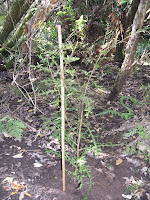 We have planted 48 kahikatea and 40 Astelia grandis under the willow canopy just north of the foot bridge. These plants have been raised by us with this location in mind. The aim is to return the gully floor back to a wetland kahikatea forest. The trees were planted approximately 5 metres apart with a 2-year slow release fertiliser tablet under each one.
We have planted 48 kahikatea and 40 Astelia grandis under the willow canopy just north of the foot bridge. These plants have been raised by us with this location in mind. The aim is to return the gully floor back to a wetland kahikatea forest. The trees were planted approximately 5 metres apart with a 2-year slow release fertiliser tablet under each one. The Astelia grandis were planted around existing adult plants to form groves.
The Astelia grandis were planted around existing adult plants to form groves.We still have about 90 kahikatea and about 40 Astelia that we will grow on until next autumn before we plant them further up the gully.
Mahoenui Giant Wetas

While this is not directly connected to Mangaiti Restoration, I thought I would share with you some photos I took while I was on assignment to collect 100 Mahoenui Giant Wetas to be released into the southern enclosure of the Maungataurtari Ecological Island. These wetas are remarkable insects.
A summary of some facts that may be of interest:
· The Giant Weta can weigh as much as 25g and the body can measure up to 65mm.
· They have a three-year life cycle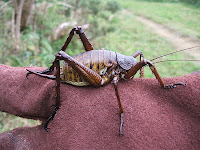
· They do not sting or bite.
· They were first discovered in 1962
· Their only known natural location in New Zealand is a few hundred hectares of gorse in the King Country south east of Piopio.
· They have survived in the gorse because of the difficulty rats have in predating them in that environment.
· Their natural habitat is in the canopy of tawa trees.
· Only two of eight translocation attempts have been successful to date.
· This is the first attempt to release them into Maungataurtari.
In the photos the only reason we are wearing gloves is because of the gorse.
Photo 1. The gorse reserve
Photo 2. Female weta
Photo 3. Male weta
Photo 4. Wetas mating!
A summary of some facts that may be of interest:
· The Giant Weta can weigh as much as 25g and the body can measure up to 65mm.
· They have a three-year life cycle

· They do not sting or bite.
· They were first discovered in 1962
· Their only known natural location in New Zealand is a few hundred hectares of gorse in the King Country south east of Piopio.
· They have survived in the gorse because of the difficulty rats have in predating them in that environment.
· Their natural habitat is in the canopy of tawa trees.
· Only two of eight translocation attempts have been successful to date.

· This is the first attempt to release them into Maungataurtari.
In the photos the only reason we are wearing gloves is because of the gorse.
Photo 1. The gorse reserve
Photo 2. Female weta
Photo 3. Male weta
Photo 4. Wetas mating!
Friday, April 6, 2012
Preparation for autumn planting
 The Wednesday working bees have been preparing the ground for the autumn planting. The four main target areas are;
The Wednesday working bees have been preparing the ground for the autumn planting. The four main target areas are;1/ South of the walk bridge where the Glyceria has been sprayed off and the Willows trimmed back.
2/ Mass planting of Kahikatea and Astelia that we have raised ourselves are to go under the canopy from the board walk north.
3/ The gully side at the back of Sexton Road where the three Kauri are (behind No. 43).
4/ Under-canopy planting on the drier gully sides of 148 Kawakawa Macropiper excelsum that we have grown from seed. These are frost tender so we will be picking sheltered sites.
Giant Sedge Gahnia xanthocarpa one year on

 Like Mainland Cheese, “good things take time”. These twenty three seedlings have just been transplanted from their seed raising tray. Wayne Bennett said at the time we collected the seed from Pukemokemoke last year that it takes about twelve months to grow. It was sown on the 6th March 2011 and these are the seedlings twelve months later. The photo with the pack shows the fully grown sedge that the seed was gathered from.
Like Mainland Cheese, “good things take time”. These twenty three seedlings have just been transplanted from their seed raising tray. Wayne Bennett said at the time we collected the seed from Pukemokemoke last year that it takes about twelve months to grow. It was sown on the 6th March 2011 and these are the seedlings twelve months later. The photo with the pack shows the fully grown sedge that the seed was gathered from.
Native Weta

 During one of our storms last month a Kanuka, down from the walk bridge, was blown over. When cutting it up for removal (firewood) it was noticed that there was a large Weta hole in the trunk. That section was kept aside and made into a Weta hotel. The Weta was coaxed out with a piece of apple as a lure, stored among forest litter in a shoe box while the trunk was converted, then reintroduced and installed back onto a tree in the gully.
During one of our storms last month a Kanuka, down from the walk bridge, was blown over. When cutting it up for removal (firewood) it was noticed that there was a large Weta hole in the trunk. That section was kept aside and made into a Weta hotel. The Weta was coaxed out with a piece of apple as a lure, stored among forest litter in a shoe box while the trunk was converted, then reintroduced and installed back onto a tree in the gully.Unfortunately, but not surprisingly, the Weta had had enough by then and has not been seen since. It is hoped that another Weta will discover a really cosy home and take up residence. There are signs of a good Weta population in the area.

Fish Hotels

 Yes it has been a month of building accommodation for our fauna. On advice from Waikato Regional Council Fish Scientist we have started installing accommodation to attract more native fish to our stream. Four concrete block hotels were installed in ponds in the gully behind Sexton Road. The target fish are Giant and Banded Kokopu.
Yes it has been a month of building accommodation for our fauna. On advice from Waikato Regional Council Fish Scientist we have started installing accommodation to attract more native fish to our stream. Four concrete block hotels were installed in ponds in the gully behind Sexton Road. The target fish are Giant and Banded Kokopu.To complement this we are planting the stream banks with Carex to provide shade and possible egg-laying sites.
Wednesday, February 29, 2012
HCC open day at Mangaiti Gully
Hamilton City Council in conjunction with Continuing Education Waikato University is running a number of Hamilton gully open days and lectures on gully restoration. They have scheduled a visit to Mangaiti Gully this Sunday 3rd March at 10am. If you would like to catch up on what is going on in your neighbourhood you would be most welcome to join us. We will be meeting at the concrete pad below the foot bridge which runs from 1 Grenache Place to 60 St James Drive.
Sexton Road track.

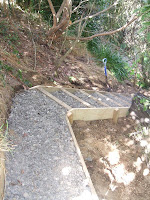 Work continued over the last month to upgrade the Sexton Road end of the track. A set of steps was built, retaining work was done on the downhill track and the track was extended over the soft mud area using heavy grade rubber tracking from an earth moving machine as a base. HCC supplied all the timber. Well worth a look if you are out walking.
Work continued over the last month to upgrade the Sexton Road end of the track. A set of steps was built, retaining work was done on the downhill track and the track was extended over the soft mud area using heavy grade rubber tracking from an earth moving machine as a base. HCC supplied all the timber. Well worth a look if you are out walking. Landcare Action Conference gully visit
Subscribe to:
Posts (Atom)
















